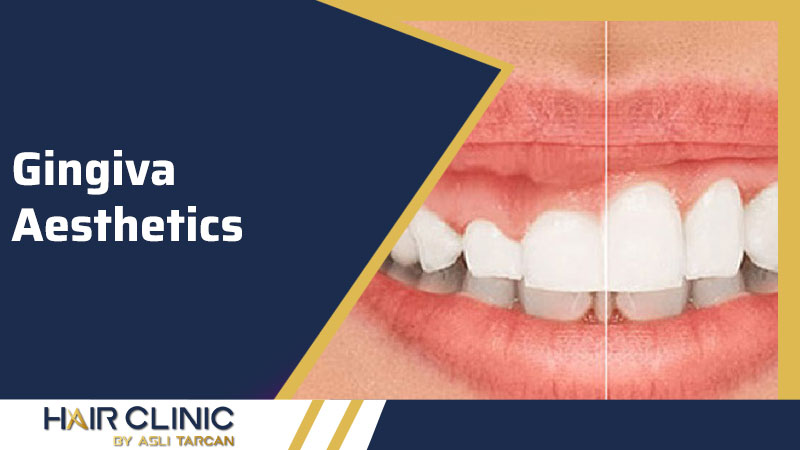Gingiva Aesthetics To achieve an aesthetic and harmonious smile, the teeth and gingivas around them must match. In addition to beautiful, straight teeth, the gingivas should be pink, healthy, and not have large variations in the way they surround different teeth. Sometimes the gingivas have height defects, showing more root in some teeth than in others. The tumor can also vary, such as when, for example, depression is left in the gums due to shrinkage of the underlying bone. This issue is resolved through a gingiva aesthetics implant.
Gingiva implants consist of removing the gingivas from one part of the mouth and implanting them in another.
The most common aesthetic interferences of the gingivas
Covering an exposed root
Technique
In case of contraction of the gums that leave the root exposed, a gingiva graft can be done. Here the elongate root is covered with a small piece of the patient’s gum, sewn to the gingiva portion that covers the adjacent teeth.
This part of the gum used to cover the root is taken from the adjacent gingiva, without removing it completely, pulling it to one side to cover the exposed root. This is known as a pedal implant.
Sometimes the gingiva piece is taken from the palate or other parts of the mouth, removing it completely and using it to cover the root. This is known as a free gingiva aesthetics transplant. To complete the process, the piece is sewn firmly on both sides of the covered root.
Evolution
One week after surgery, both the implant and the area from which they were received would have healed quite well and the sutures could be removed from the treated area.
It will take two months to complete the healing process and for the aesthetic result to be stable and permanent
Depending on each case, for how complicated the surgery was, for the patient’s hygiene after surgery, and, most importantly, for the initial amount of root exposed, we could completely or partially cover the receding gums.
Precautions
You need to take precautions when eating, especially during the first ten days. Be careful not to chew on the graft area or eat hard foods such as nuts or others that are too salty or irritating.
Workplace hygiene is essential, using an oral solution containing the antiseptic chlorhexidine.
Be careful not to brush the implant immediately for a week or two, depending on how the healing process progresses.
Smoking has a negative effect on the surgical and aesthetic effect of the implant.
Patients should try not to smoke for three days before and ten days after surgery. This is necessary.
Thickening of the gingivas
When a tooth is extracted, a gap appears in the gums, which is sometimes not sufficiently filled by the bone. This means that the bone and therefore the gingivas are thinner in the area and that a hole can be felt.
In the case of an upper front tooth, when we want to place a bridge or an implant, we have to fill this space with gum, so that the tooth that is added at a later stage no longer seems to be one of its neighbors. To do this we will make a gingiva aesthetics implant. If the space was too large, a bone graft would be needed either by the patient or artificially.
The fattening graft includes techniques similar to those described for the root canal.
The evolution and precautions are also similar to the function described above.
If the aesthetics of your gingivas, and therefore your smile, require improvement, let us know at the next check-up.
Gum Implant
A gingiva implant (also known as a gum implant or periodontal plastic surgery) is a collective name for periodontal surgery that aims to cover an exposed tooth root surface with inoculated oral tissue.
Exposed tooth roots are usually the result of receding gums due to periodontal disease. There are other common causes, such as excessive brushing and trauma.
Here are some of the most common types of gingiva implants:
- Free Gum Implant This procedure is often used for gingiva tissue density. A layer of tissue is removed from the palate and transferred to the area affected by the receding gums. Both sites will heal quickly without permanent damage.
- Hypophthalmic connective tissue graft This procedure is commonly used to cover exposed roots. The tissue is removed quite painlessly from the outer layer of the palate and transferred to the point of the recession of the gingivas.
- Uterine Skin Transplant This procedure uses medically treated, donated human tissue as a source of tissue for the implant. The advantage of this procedure is that there is no need for a donor position from the patient’s palate (and therefore less pain).
Reasons for gum vaccination
Gingiva aesthetics vaccination is a common periodontal procedure. Although the name may sound scary, the process is usually performed with excellent results.
Here are some of the most important benefits associated with gum vaccination:
- Decreased Sensitivity When the tooth root is exposed, eating hot or cold foods can cause extreme tooth sensitivity. Gingiva grafting surgery permanently covers the exposed root, helps reduce discomfort, and restores good gum health.
- Improved appearance Periodontal disease is characterized by receding gingivas and inflammation. Aggregated gums and exposure to roots can make teeth look longer than normal and a smile look “jagged”. Gingiva vaccination can make teeth look closer, more symmetrical, and generally more pleasant. In addition, the surrounding tissue can be strengthened and enhanced during the procedure for aesthetic purposes.
- Improved gum health Periodontal disease can progress and destroy gingiva tissue very quickly. If left untreated, a large amount of gum tissue can be lost in a short time. Gingiva vaccination can stop tissue and bone loss. prevent further problems and protect the exposed roots from further damage
What does gum transplant treatment include?
Once the need for gingiva aesthetics transplant surgery is identified, there are several treatments that the dentist will want to perform before the gum vaccination is performed. First, the teeth need to be thoroughly cleaned and dipped to remove tartar and bacteria. The dentist can also provide literature, advice, and training tools to increase the effectiveness of home care and help reduce susceptibility to periodontal disease in the future.
As long as these recommendations are followed, oral health will be preserved and the treatment will be successful. It should not be forgotten that the home care process has a very important place in treatment.
The gingiva vaccination procedure is usually performed under a local anesthetic. The exact procedure will depend a lot on whether the tissue comes from the patient’s palate or from a tissue bank.
Initially, small incisions will be made in the recipient’s site to create a small pocket to house the implant. A thickness separation incision is then made and the connective tissue implant is inserted into the space between the two sections of tissue. The implant is usually slightly larger than the recessed area, so some excess will appear.
Sutures are often placed to further stabilize the implant and prevent any displacement from the specified position. The surgical material is used to protect the surgical site during the first week of treatment. Gum uniformity and healing will be achieved in about six weeks.
If you have any questions about gingiva vaccination, ask your dentist at our clinic.
Contours of the gums
If your gingivas rest too low or too high on your teeth and you are unhappy with your smile, you may be a candidate for gum surgery. This cosmetic dental procedure can also reveal an uneven line of the gingivas and give you a smile that you can be proud of.
What causes uneven gums?
Some things can cause your gingivas to be too low or too high. The gums that cover most of your teeth can make your teeth look small. This may be due to a genetic problem related to health or taking certain prescription drugs.
Gingivas that are too high and make your teeth look long are often caused by sagging gums, a condition in which gingiva tissue pulls behind a tooth and exposes the tooth root. Not only does gum wear to make your teeth look big, but it can also lead to serious dental problems such as tooth decay and loss. Decreased gingivas can also be a sign of periodontal disease, deterioration of the supporting structures of the teeth (gums and bones).
Gingiva Aesthetics Contour Surgery: Is It Necessary?
The contour of the gums alone is considered an aesthetic process. Most of the time it is not medically necessary. Most people have reshaped their gingivas to improve the appearance of their smile. However, some people undergo gum contour surgery as part of other necessary periodontal procedures, such as crown lengthening, pocket reduction, and regenerative procedures.
Non-cosmetic gingiva contouring procedures include the addition of gum tissue when a recession has occurred and the removal of excess tissue that has covered part of the crown of the teeth.
What kind of doctors perform a gingiva contour?
Many general dentists and periodontists (gum specialists) can perform the gingiva contouring procedure. Before completing the procedure, ask your dentist for his knowledge and experience with the procedure.
Contouring Gum: How much does it cost?
The cost of the gingiva aesthetics contour depends on the amount of work done. Talk to your dentist about costs based on your individual needs. Dental insurance usually does not cover the contour of the gums for cosmetic purposes.
Gingiva contours: What to expect
Gum surgery is performed at the dentist’s office. Currently, dentists use scalpels, lasers, and radiosurgery to perform the gingiva contouring procedure. Ask your dentist which technique would be most appropriate for your case.
Before the surgery, your doctor should consider what he will do during the procedure. Often, dentists use a pen and draw a line to mark the new line of the gums. This way, you can see exactly how much gingiva will be removed or how the gingiva line will be re-formed.
A local anesthetic may be applied to numb the area. Sometimes, the bone in the front of the tooth root also needs to be removed when shaping the gingivas for better long-term results.
Gum contours: Recovery
On the day of surgery, you need to rest and limit your activities. It may take a few days or weeks for your gingivas to heal completely. Your dentist will give you specific instructions on what you need to do to help the recovery process. Here are some general tips to get you through the recovery period:
- Relieve the pain by taking an over-the-counter painkiller, such as Tylenol or Advil, as directed by your dentist. Do not take aspirin, which may cause bleeding.
- Eat soft, cool foods, such as eggs, pasta, yogurt, cottage cheese, soft vegetables, and ice cream, for the first few days after surgery. Avoid spicy foods and anything with the seeds until your gingivas are completely healed.
- Follow your dentist’s instructions on when and how to brush your teeth during the treatment process.
- If you notice excessive swelling or bleeding or if you have any concerns after the procedure, call your dentist.
Gingiva aesthetics contours: The dangers
There is no risk-free surgery. Risks associated with gum contouring include:
- Allergic reaction to anesthetic (rare)
- Repetition of gingiva tissue
If you are not happy with the way your teeth and gums look, talk to your dentist to see if gingiva surgery is right for you. But remember, as, with any cosmetic procedure, the end result depends on the ability of the doctor. Make sure you are comfortable with the dentist’s skills. Ask the dentist what additional training he had in cosmetic dentistry. Also, ask to see photos of the work he has done and make sure you like what you see.
All of the dentists in our clinic are experienced and professional physicians. They have successfully treated hundreds of times against different dental and gingiva diseases. You can learn other things you want to know about gingiva aesthetics by contacting our clinic.



